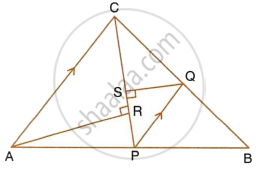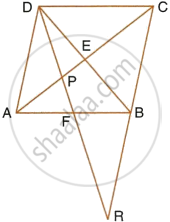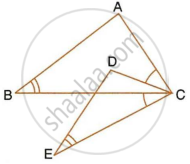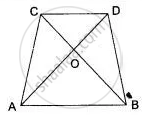Advertisements
Advertisements
Question
In the given figure, P is a point on AB such that AP : PB = 4 : 3. PQ is parallel to AC.

- Calculate the ratio PQ : AC, giving reason for your answer.
- In triangle ARC, ∠ARC = 90° and in triangle PQS, ∠PSQ = 90°. Given QS = 6 cm, calculate the length of AR.
Solution
i. Given, AP : PB = 4 : 3.
Since, PQ || AC.
Using Basic Proportionality theorem,
`(AP)/(PB) = (CQ)/(QB)`
`=> (CQ)/(QB) = 4/3`
`=> (BQ)/(BC) = 3/7` ...(1)
Now, ∠PQB = ∠ACB ...(Corresponding angles)
∠QPB = ∠CAB ...(Corresponding angles)
∴ ΔPBQ ~ ΔABC ...(AA similarity)
`=> (PQ)/(AC) = (BQ)/(BC)`
`=> (PQ)/(AC) = 3/7` ...[Using (1)]
ii. ∠ARC = ∠QSP = 90°
∠ACR = ∠SPQ ...(Alternate angles)
∴ ∆ARC ~ ∆QSP ...(AA similarity)
`=> (AR)/(QS) = (AC)/(PQ)`
`=> (AR)/(QS) = 7/3`
`=> AR = (7 xx 6)/3 = 14 cm`
APPEARS IN
RELATED QUESTIONS
Given: RS and PT are altitudes of ΔPQR. Prove that:
- ΔPQT ~ ΔQRS,
- PQ × QS = RQ × QT.
Given: ABCD is a rhombus, DPR and CBR are straight lines.

Prove that: DP × CR = DC × PR.
In ∆ ABC, ∠B = 2 ∠C and the bisector of angle B meets CA at point D. Prove that:
(i) ∆ ABC and ∆ ABD are similar,
(ii) DC: AD = BC: AB
In ∆PQR, ∠Q = 90° and QM is perpendicular to PR. Prove that:
- PQ2 = PM × PR
- QR2 = PR × MR
- PQ2 + QR2 = PR2
In ∆ABC, ∠B = 90° and BD ⊥ AC.
- If CD = 10 cm and BD = 8 cm; find AD.
- If AC = 18 cm and AD = 6 cm; find BD.
- If AC = 9 cm and AB = 7 cm; find AD.
Through the mid-point M of the side CD of a parallelogram ABCD, the line BM is drawn intersecting diagonal AC in L and AD produced in E. Prove that: EL = 2BL.
In the figure, given below, ABCD is a parallelogram. P is a point on BC such that BP : PC = 1 : 2. DP produced meets AB produces at Q. Given the area of triangle CPQ = 20 cm2.

Calculate:
- area of triangle CDP,
- area of parallelogram ABCD.
In the given figure, ∠B = ∠E, ∠ACD = ∠BCE, AB = 10.4 cm and DE = 7.8 cm. Find the ratio between areas of the ∆ABC and ∆DEC.

An aeroplane is 30 m long and its model is 15 cm long. If the total outer surface area of the model is 150 cm2, find the cost of painting the outer surface of the aeroplane at the rate of Rs.120 per sq. m. Given that 50 sq. m of the surface of the aeroplane is left for windows.
In fig. ABCD is a trapezium in which AB | | DC and AB = 2DC. Determine the ratio between the areas of ΔAOB and ΔCOD.
